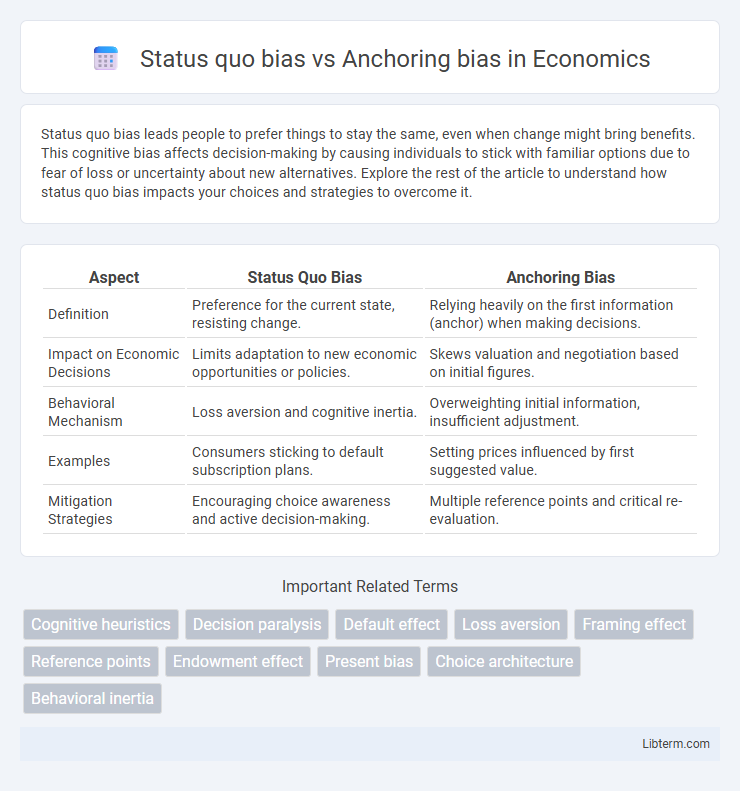Status quo bias leads people to prefer things to stay the same, even when change might bring benefits. This cognitive bias affects decision-making by causing individuals to stick with familiar options due to fear of loss or uncertainty about new alternatives. Explore the rest of the article to understand how status quo bias impacts your choices and strategies to overcome it.
Table of Comparison
| Aspect | Status Quo Bias | Anchoring Bias |
|---|---|---|
| Definition | Preference for the current state, resisting change. | Relying heavily on the first information (anchor) when making decisions. |
| Impact on Economic Decisions | Limits adaptation to new economic opportunities or policies. | Skews valuation and negotiation based on initial figures. |
| Behavioral Mechanism | Loss aversion and cognitive inertia. | Overweighting initial information, insufficient adjustment. |
| Examples | Consumers sticking to default subscription plans. | Setting prices influenced by first suggested value. |
| Mitigation Strategies | Encouraging choice awareness and active decision-making. | Multiple reference points and critical re-evaluation. |
Understanding Cognitive Biases: An Introduction
Status quo bias leads individuals to prefer existing conditions, resisting change even when alternatives may offer better outcomes. Anchoring bias causes people to rely heavily on the first piece of information encountered when making decisions, often skewing judgment. Both cognitive biases influence decision-making processes by limiting objective evaluation and reinforcing suboptimal choices.
Defining Status Quo Bias
Status quo bias is a cognitive tendency where individuals prefer to maintain their current state or decision, avoiding change even when alternatives may offer better outcomes. This bias causes people to resist change due to fear of loss, uncertainty, or effort associated with making a new choice. Unlike anchoring bias, which relies heavily on initial reference points affecting judgment, status quo bias centers on the preference for familiarity and the inertia of established habits.
Defining Anchoring Bias
Anchoring bias occurs when individuals rely heavily on an initial piece of information, or "anchor," to make subsequent judgments and decisions, often leading to skewed or insufficiently adjusted outcomes. This cognitive bias affects various fields such as negotiations, pricing, and decision-making by causing people to cling to the first available data point despite new information. Unlike status quo bias, which favors maintaining the current state, anchoring bias distorts evaluations based on early anchors rather than a desire to preserve existing conditions.
How Status Quo Bias Influences Decision-Making
Status quo bias influences decision-making by causing individuals to prefer maintaining existing conditions rather than making changes, often leading to resistance against new options or innovations despite potential benefits. This cognitive bias stems from a desire to avoid loss and the perceived effort of change, resulting in suboptimal choices that favor familiarity over improvement. Unlike anchoring bias, which depends on initial information or reference points, status quo bias anchors decisions in the comfort of current states, impacting consumer behavior, organizational change, and personal habits.
The Mechanisms Behind Anchoring Bias
Anchoring bias occurs when individuals rely heavily on an initial piece of information (the anchor) to make subsequent judgments, often leading to skewed decision-making despite contrary evidence. This cognitive mechanism exploits the human tendency to insufficiently adjust away from the anchor, causing estimates or decisions to remain biased toward the starting point. In contrast to status quo bias, which favors existing conditions, anchoring bias specifically involves the disproportionate influence of initial information on cognitive processing and choice.
Key Differences Between Status Quo Bias and Anchoring Bias
Status quo bias leads individuals to prefer existing conditions and resist change, while anchoring bias causes reliance on the first piece of information encountered when making decisions. Status quo bias influences decisions by maintaining current choices due to comfort and familiarity, whereas anchoring bias skews judgment by anchoring on initial numerical or contextual information. Understanding these key differences helps in identifying decision-making errors caused by preference persistence versus initial data fixation.
Real-World Examples of Status Quo Bias
Status quo bias leads individuals to prefer maintaining current situations rather than changing, exemplified by employees resisting new workplace technologies despite proven efficiency gains. In retirement savings, many stick with default contribution rates, reflecting reluctance to alter familiar settings even when higher contributions would be beneficial. Health behaviors also show this bias when patients continue ineffective treatments simply to avoid changing routines.
Real-World Examples of Anchoring Bias
Anchoring bias occurs when individuals rely heavily on the first piece of information encountered, influencing subsequent judgments and decisions, as seen in real estate pricing where initial listing prices set buyer expectations. In negotiations, the first offer often serves as an anchor, swaying counteroffers closer to that initial figure regardless of objective value. Retail pricing strategies exploit anchoring by showing original prices beside discounted rates, leading consumers to perceive greater value and make purchases based on the anchored reference point.
The Impact of Both Biases in Everyday Life
Status quo bias leads individuals to prefer maintaining current conditions, often hindering beneficial changes in decision-making processes. Anchoring bias causes excessive reliance on initial information, skewing judgments and evaluations in areas such as pricing, negotiations, and risk assessment. Both biases significantly influence consumer behavior, financial choices, and policy preferences, reinforcing resistance to change and limiting objective analysis.
Strategies to Overcome Status Quo and Anchoring Biases
To overcome status quo bias, employ proactive decision-making techniques such as setting clear goals, evaluating alternatives using objective criteria, and seeking diverse perspectives to challenge inertia. Counter anchoring bias by deliberately considering a wide range of reference points, conducting independent research, and using structured decision-making tools that minimize reliance on initial information. Implementing regular feedback loops and training in cognitive bias awareness further helps reduce the influence of both biases in decision processes.
Status quo bias Infographic

 libterm.com
libterm.com